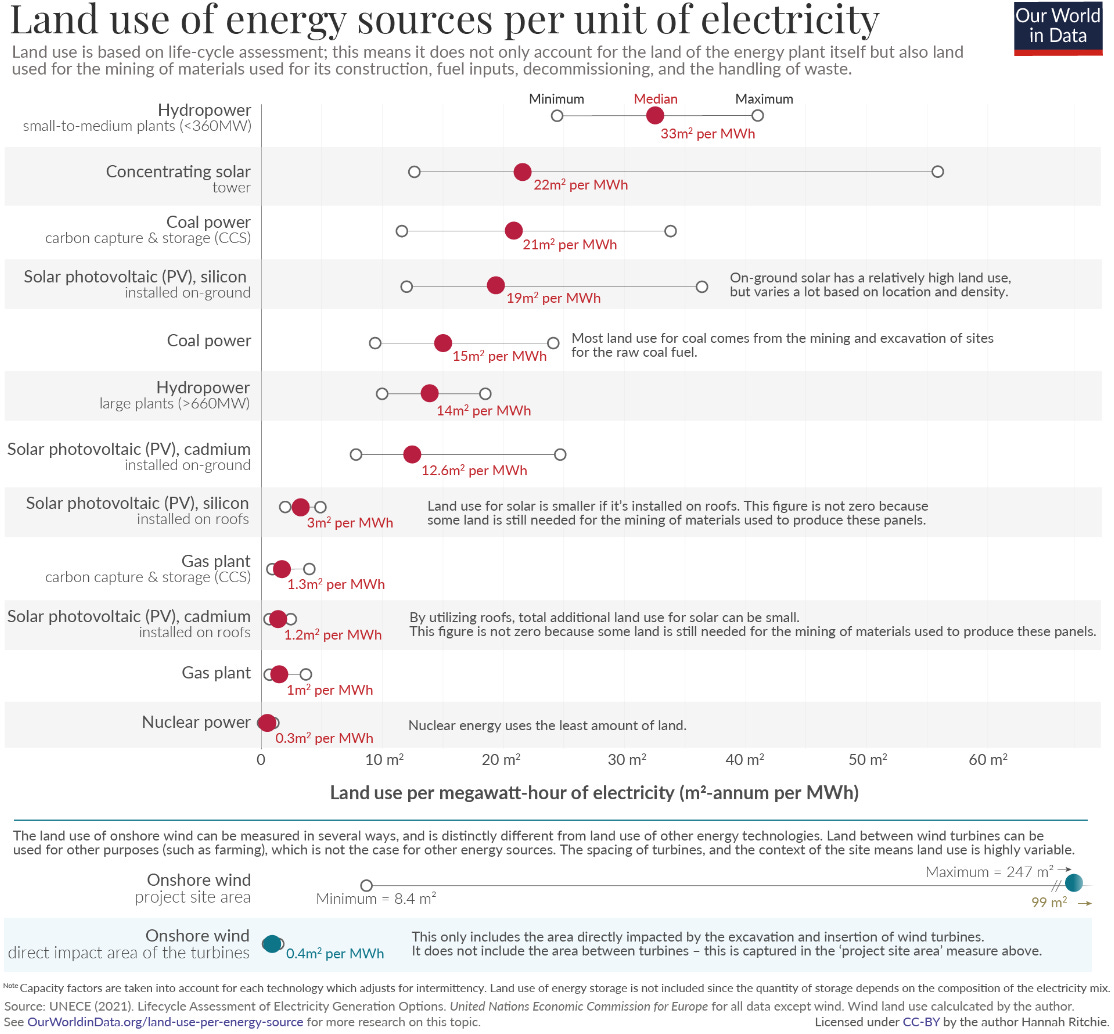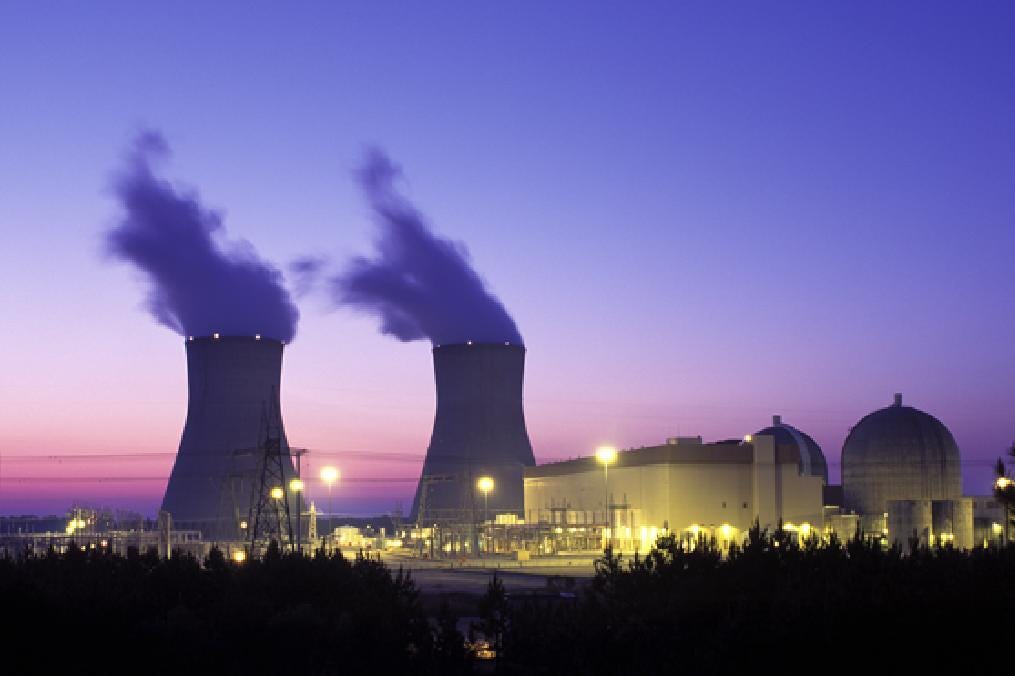Nuclear Power and 526 Deer
Where we show mathematically that solar farms east of the Mississippi should be banned in favor of nuclear
This article is going to be tough to write because I do, in fact, work professionally on design teams for solar farms in Georgia and across the southeast. I don’t design the power generation. I design the stormwater management features to ensure they don’t flood their neighbors out during storms after they knock down all the trees. But when I take a broader look at opportunity costs and impacts on the environment, I still find that they are fantastically worse than nuclear power, and I think I can make that clear for anyone by using a little mathematics and data visualization. Let’s do some math.
Land Area Comparison
Our World In Data published a very good analysis of the land use burdens per megawatt hour of power generated by different power generation means, including not only the power plant itself, but the harvesting of the fuel and the materials to build the plant. This is their punchline graph:
Nuclear power takes up the least amount of space, and the error bands on the measurement are the smallest. Hydropower takes up quite a lot because you have to make a lake to do it, although I don’t think that’s particularly fair because lakes are cool. Coal is bad mostly because it’s strip mined, and solar photovoltaic (PV) cells are bad when they’re installed on the ground in a farm, because the farms are quite large and you have to tear up habitat to make some of them.

Certain pundits and mid tier politicians (see: Shellenberger above) have thrown around the land use argument against solar, and supported it with emotional imagery and such, but few of them take the time to do the math, or present it clearly.
Nuclear power takes up 0.3 square meters per megawatt hour, while solar takes up 19 square meters per megawatt hour, according to the chart above. Plant Vogtle in Georgia produces 19,176 gigawatt hours of power per year with it’s two current reactors, and is in the process of perhaps someday hopefully maybe adding two more.
19,176 GWh of power is 19,176,000 MWh of power, which according to Our World in Data is the same as a solar field 63.9 million square meters in area might produce. But how big is that? Nobody can understand how big 63.9 million square meters is. Let’s convert it.
The Hypothetical Vogtle Replacement Solar Field is 15,795 acres, or 6,392 hectares, or 24.6 square miles, or 63.92 square kilometers, or the approximate size of Albany New York. If you’re on the west coast, Huntington Beach California is about the same size. Not some of the city, not portions of the city, the whole city.
If you live out in the arid plains of Nevada a solar field that size may be of no consequence, since you probably don’t live out in the arid plains of Nevada, because nobody lives out in the arid plains of Nevada unless you’re the Minister of Science of the Republic of Molossia. But solar farms in areas that have forests, and habitats, and people, necessarily come with an opportunity cost which must be weighed against this land use if we’re going to be good environmentalists.
Forest Comparison
Most land east of the Mississippi River is forest in its natural state. A 50 year old forest sequesters 0.8 metric tons of carbon annually by capture in leaf litter and subsequent decomposition into the soil. A 65 year old forest sequesters double that - 1.6 metric tons of carbon per year. A 65 year old forest which gets demolished in order to build the Hypothetical Vogtle Replacement Solar Field would sequester 25,212 metric tons of CO2 per year, or 55,714,986 pounds of CO2, or 477,254,569 cubic feet of CO2. And now our eyes glaze over again because we can’t conceive of these big numbers, so we do what we did last time around and convert it to hot air balloons.
The 65 year old forest we plow to replace Plant Vogtle naturally sequesters 6,154 hot air balloons worth of carbon per year into the earth, which is 10.3 Albuquerque Hot Air Balloon Festivals worth of carbon.
Or visualized another way:
And it’s not just the carbon.
Habitat Comparison
The Hypothetical Vogtle Replacement Solar Field is as large as 19 copies of New York City’s Central Park side by side, or 29 copies of the Muir Woods National Monument stuck together, or 1.75 times bigger than the largest state park in the entire state of Georgia. And solar fields have to be fenced off from wildlife to prevent the wildlife from interfering with the field.
At a population density of approximately thirty acres per deer, this solar field displaces 526 deer. At four red foxes per square mile, the solar field permanently reduces the red fox population by 99 individuals. At a median guess of eleven bobcats per 100 square kilometers, this solar field destroys seven bobcats worth of habitat. And so on and so forth. Add all the animals up, pretend birds are real and add those too, and you can start to see the overall environmental impact of converting some place like Vogtle to solar. It’s all just generally awful.
If we are going to make an environmentalist case for solar, and we take externalities and environmental opportunity cost into effect, it becomes clear that any place in the United States with trees and animal populations should not be converted to solar. A Nevada moonscape may be a completely reasonable location for such a project, environmentally speaking, but encouraging or forcing the eastern half of the country to do it does more harm than good.









My one-sentence takeaway might be this:
The lifecycle of solar power uses ~60 times more land than nuclear power per MWh, and it's far greener (literally) to build 1 acre of nuclear plant amid 59 acres of forest than to raze 60 acres of forest for a solar farm.
Of course, all the worries about nuclear safety may be better founded than it's polite to admit - there's a reason why the white South Africans dismantled their nuclear weapons program, and I recommend reading through the Wiki page on one of the remaining civilian nuclear plants in the country - it's not pretty: https://en.wikipedia.org/wiki/Koeberg_Nuclear_Power_Station
As atoms don't cause nuclear incidents by themselves, concerns about 'nuclear safety' as such are in fact euphemistically phrased concerns about the competence of plant operation, faith in which, especially in the coming generations, may be stronger than is prudent.
That is to say, there are bigger concerns at play than verdancy.
If anyone is putting solar over anything other than roofs, condemned toxic waste sites, arid sand, lawns, parking lots, golf courses, or football fields, they should stop immediately. Every single family home can provide enough energy with panels. Why we would prefer centralized farms over dispersed privately owned solar is beyond me.
The argument here is definitely straw man. But only because of the idiocy of governments and greedy “green” companies building the straw man for you.